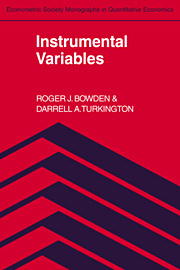4 - Linear simultaneous equations
Published online by Cambridge University Press: 05 January 2013
Summary
Introduction
The topic of simultaneous stochastic equations will be familiar to readers who have some acquaintance with empirical economics, for it is in econometrics that this methodology has been worked out most fully. On the other hand, one can conceive of situations where variables are jointly determined as the solution to simultaneous equations in other contexts. In population dynamics, for example, the number of predators (lynxes, say) may depend upon the number of prey (snowshoe hares), and likewise the number of hares will depend upon the number of lynxes; and although such a dependence will unquestionably have dynamic elements, it is nevertheless essentially simultaneous. In view of the historical development of simultaneous stochastic equation theory, however, it is perhaps inevitable that an economic flavor creeps into the discussion. For this reason, it will be as well to commence with a very brief and simple outline of the essential problems involved in the simultaneous context. The reader who can understand these examples should have no difficulty with the remainder of the chapter. Indeed, it will be found that the methodology of instrumental variables, as it has appeared in previous chapters, offers a relatively painless approach to the topic for the reader whose statistical numeracy outruns his economic literacy. On the other hand, the econometrician may like to skip directly from this point to Section 4.2, perhaps pausing to look at the chapter outline at the end of the present section.
- Type
- Chapter
- Information
- Instrumental Variables , pp. 98 - 155Publisher: Cambridge University PressPrint publication year: 1985



